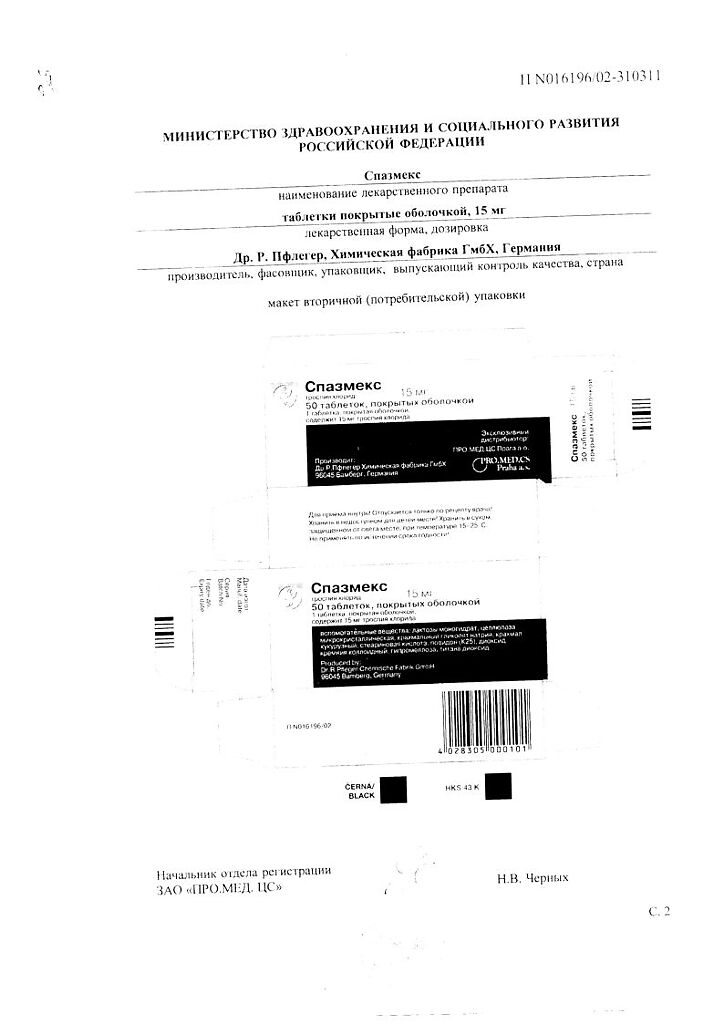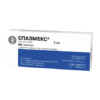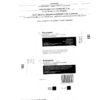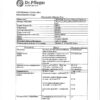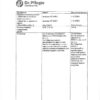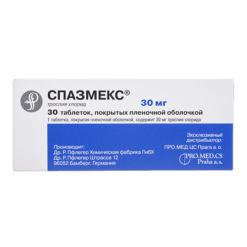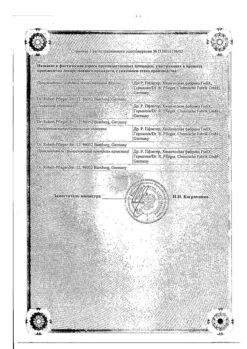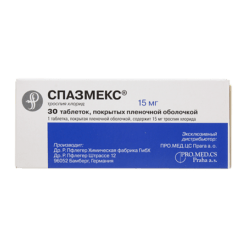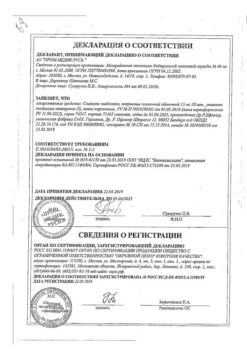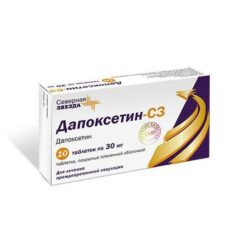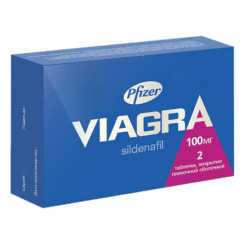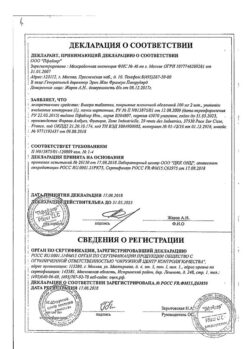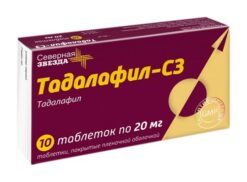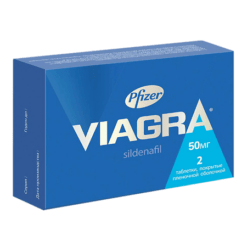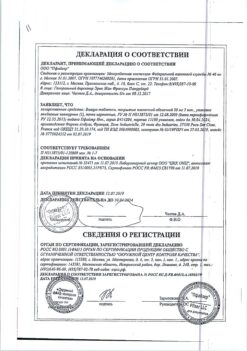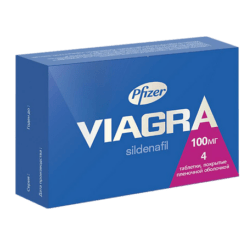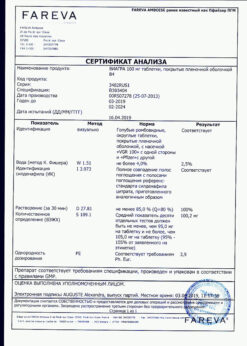No products in the cart.
Spasmex, tablets 5 mg 30 pcs
€15.86 €13.21
Description
Pharmacodynamics
Trospium chloride is a quaternary ammonium base, belongs to the group of m-cholinoblockers. It is a competitive antagonist of acetylcholine at the receptors of postsynaptic membranes of smooth muscles. It has high affinity to m 1 – and m 3 -cholinoreceptors. Reduces increased activity of the detrusor of the bladder. It has antispasmodic and some ganglioblocking effects. It has no central effects.
Pharmacokinetics
Absorption and distribution
Maximum plasma concentration of trospium chloride (C max ) is reached 4-6 hours after oral administration of trospium chloride; elimination half-life (T 1/2 ) averages 5-18 hours, does not cumulate. Binding to plasma proteins is 50-80%. Plasma concentration of trospium chloride when administered orally in a single dose of 20-60 mg is proportional to the dose taken.
Metabolism and excretion
The prevailing amount of trospium chloride is excreted unchanged by kidneys, a smaller part (about 10%) – as spiroalcohol metabolite formed during hydrolysis of ester bonds.
Indications
Indications
Urinary incontinence, imperative urge to urinate (with idiopathic hyperreactivity of the detrusor; with neurogenic hyperactivity (hyperreflexia) of the detrusor against the background of multiple sclerosis, spinal injuries, congenital and acquired diseases of the spinal cord, strokes, Parkinsonism).
Detrusor-sphincter dyssynergia against the background of intermittent catheterism.
In the complex therapy of cystitis accompanied by imperative symptoms.
Pollakiuria, nocturia.
Nocturnal and daytime enuresis.
Mixed forms of urinary incontinence.
Pharmacological effect
Pharmacological effect
Pharmacodynamics
Trospium chloride is a quaternary ammonium base and belongs to the group of m-anticholinergic agents. It is a competitive antagonist of acetylcholine at receptors of postsynaptic smooth muscle membranes. It has a high affinity for m 1 and m 3 cholinergic receptors. Reduces increased activity of the bladder detrusor. It has an antispasmodic and some ganglion-blocking effect. Does not have central effects.
Pharmacokinetics
Suction and distribution
The maximum concentration of trospium chloride in blood plasma (Cmax) is achieved 4-6 hours after oral administration of trospium chloride; The half-life (T 1/2) averages 5-18 hours, does not accumulate. Binding to plasma proteins is 50-80%. The concentration of trospium chloride in blood plasma after a single oral dose of 20-60 mg is proportional to the dose taken.
Metabolism and excretion
The predominant amount of trospium chloride is excreted by the kidneys unchanged, a smaller part (about 10%) is in the form of a spiroalcohol metabolite formed during the hydrolysis of ester bonds.
Special instructions
Special instructions
Taking the drug in case of dysfunction of the internal urethral sphincter or bladder detrusor should be accompanied by its complete release through catheterization.
In case of autonomic disorders of the bladder, the cause of dysfunction must be determined before treatment begins; organic causes of pollakiuria, nocturia and urinary incontinence, such as heart failure, polydipsia, the possibility of urinary tract infection and bladder cancer, are excluded, since they require etiotropic therapy.
Impact on the ability to drive vehicles and other mechanisms that require increased concentration
At the beginning of treatment, when increasing the dose of the drug, replacing the drug, as well as when interacting with alcohol, vision may deteriorate, which should be taken into account when driving vehicles and working with moving mechanisms.
Active ingredient
Active ingredient
Trospium chloride
Composition
Composition
Active ingredient:
trospium chloride – 5 mg.
Excipients:
lactose monohydrate,
microcrystalline cellulose,
sodium starch glycolate,
corn starch,
stearic acid,
povidone K25,
colloidal silicon dioxide,
hypromellose,
titanium dioxide
Shell composition:
hypromellose, titanium dioxide, microcrystalline cellulose, stearic acid.
Pregnancy
Pregnancy
During pregnancy and breastfeeding, the drug should be used if the expected benefit to the mother outweighs the potential risk to the fetus or child.
Contraindicated for children under 14 years of age.
Contraindications
Contraindications
urinary retention,
glaucoma,
slower evacuation of food from the stomach and conditions predisposing to their development;
renal failure requiring dialysis (creatinine clearance (CC) < 10 ml/min/1.73 m2);
galactose intolerance;
hypersensitivity to the drug Spazmex.
Side Effects
Side Effects
From the cardiovascular system: infrequently – tachycardia; rarely – chest pain, fainting, tachyarrhythmia, hypertensive crisis.
From the gastrointestinal tract: often – dry mouth, dyspepsia, constipation, nausea, abdominal pain; infrequently – diarrhea, bloating; rarely – gastritis.
From the respiratory system: infrequently – shortness of breath.
From the nervous system: rarely – confusion, hallucinations.
From the musculoskeletal system: rarely – acute necrosis of skeletal muscles.
From the side of the organ of vision: infrequently – disturbance of accommodation.
From the urinary system: infrequently – impaired bladder emptying; rarely – urinary retention.
From the hepatobiliary system: rarely – a slight or moderate increase in transaminase activity.
From the immune system: infrequently – skin rash; rarely – anaphylactic reactions, Stevens-Johnson syndrome.
Interaction
Interaction
No interaction is expected with drugs that affect the cytochrome P 450 isoenzyme system, since trospium chloride has not been found to interact with isoenzymes CYP1A2, CYP2A6, CYP3C9, CYP2C19, CYP2D6, CYP2E1, CYP3A4, which are involved in the breakdown of drugs during metabolism.
With simultaneous use, trospium chloride enhances the anticholinergic effect of amantadine, tricyclic antidepressants, quinidine, antihistamines, disopyramide, beta-agonists.
Overdose
Overdose
Symptoms: signs of overdose are an increase in anticholinergic symptoms, such as visual disturbances, tachycardia, dry mouth and hyperemia of the skin.
Treatment: gastric lavage and intake of adsorbents (activated carbon, etc.), instillation of pilocarpine – for patients with glaucoma, catheterization of the bladder – for urinary retention.
In severe cases, cholinomimetics (neostigmine methyl sulfate) are prescribed. In case of insufficient effect, severe tachycardia and/or circulatory instability, beta-blockers are administered intravenously under ECG and blood pressure monitoring.
Storage conditions
Storage conditions
In a dry place, protected from light, at a temperature of 15–25 °C
Shelf life
Shelf life
5 years
Manufacturer
Manufacturer
Dr. Pfleger, Germany
Additional information
| Shelf life | 5 years |
|---|---|
| Conditions of storage | In a dry, light-protected place at 15-25 °C |
| Manufacturer | Dr. Pfleger, Germany |
| Medication form | pills |
| Brand | Dr. Pfleger |
Other forms…
Related products
Buy Spasmex, tablets 5 mg 30 pcs with delivery to USA, UK, Europe and over 120 other countries.


